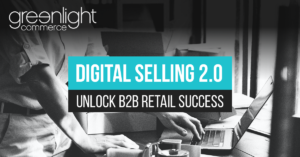Follow these FIVE tips to see how B2B leaders are engaging digital channels to increase sales.
With shops and offices forced to close, the past year and a half have underlined to B2B companies how important eCommerce is to their operations. In the absence of face-to-face meetings with sales representatives, companies have moved to online ordering and it appears it is not just a short term trend. Just 20% of B2B buyers expect to go back to in-person ordering, according to research from McKinsey.
B2B companies have traditionally been slow in developing digital selling strategies because they are used to selling face-to-face or over the phone, treating each customer and its pre-arranged contract prices individually. However, an effective digital sales platform can be used to both empower face to face selling as well as allow customers to self-serve.
The leaders in B2B sales are already making the leap. Research from McKinsey shows that, since Covid, B2B leaders are now naming eCommerce as their most effective sales route, ahead of in-person or video and telephone calls.
To be successful, there are five areas B2B organisations need to focus on to make sure their system can both support in-person selling and self-service ordering.
1 In-person selling
A digital selling platform does not have to be solely built around self-service, as B2C platforms are. It can be devised to enable staff to serve customers better during meetings or calls.
In the field, sales staff generally have to know their customers and the rates they have negotiated. The same goes for a telesales executive, who will generally need to open up the company’s CRM or sales system to find the customer’s details. Both systems mostly rely on an administrator to manually fill out an order form which, of course, is prone to error.
Any B2B organisation that builds a digital selling platform offers immediate and easy access for its staff to input the name of the business they are dealing with so they can see what they normally order, what they may have run out of and perhaps suggest alternative or related products. Most importantly, organisations can set up a screen that shows the information and prices for that particular customer to ensure a personalised service.
Orders can then be completed on the sales representative’s device, taking the paperwork out of the equation and virtually eliminating the scope for human error.
2 In-store engagement
Just as a company’s field salespeople can serve B2B customers better with a digital sales platform at their fingertips, those customers can get the best out of a retailer in-store with the right system.
With an app or website open on the device of their choice, a B2B customer can be empowered to order goods in a way most normally associated with B2C retailing. They can pick out what they need, and make sure they’re in stock, before selecting to click and collect. Alternatively, they can select items that are not in stock but can be pre-ordered so they are ready to be picked up in-store at a later date.
A good digital sales platform will also allow customers to log on when they are in-store so they can receive pricing information that matches their pre-negotiated contract.
3 Subscriptions and auto-replenishment
The beauty of a digital sales platform is that B2B companies can invite customers to sign up for regular orders.
This could be a contract to deliver a recurring order at a pre-set interval or, more informally, an email or a mobile notification reminder that, according to the system, a customer is likely to be out of a particular product soon and ought to click a button to confirm a new order.
They could also see this alert when they next log on with the offer of selecting the ‘order again’ button.
4 Self-service personalisation
If there is one lesson B2B retailers can learn from their B2C counterparts, it’s personalisation.
When a customer logs on to your online or app service, they can not only view the pricing that applies to their contract, you can also tailor what they see aligned with the categories they are most interested in, based on their industry niche and purchase order history.
Businesses can then start recommending associated products, just in the way that Amazon has its ‘often bought together to suggest associated purchases a customer can add to their basket with a single press of a button.
5 Devices and channels working together
The best B2C retailers are adept at what is known as ‘omnichannel’ experiences. People can now pretty much take for granted that with the most sophisticated retailers, an item they added to their online shopping basket on a desktop will be waiting for them when they next log in on their mobile device. They know they will get the same joined-up experience, no matter what device they are using.
Some B2B companies may think this is too sophisticated but the point they need to bear in mind is purchasers are becoming younger and more digital-savvy. The features they enjoy when shopping privately are seen as convenient parts of the everyday online buying process they expect to see when placing orders for their company.
Proof recently surfaced in research from Gartner in which 77% of B2B purchasers rated their recent buying experiences as difficult or complex. The same study pointed out that if buyers are given a convenient experience with all the right information made clearly available, they are three times more likely to make a high-value purchase.
Going all in or not
Many businesses will still feel that face-to-face selling suits their organisation. However, there is no reason why investing in a digital sales platform should curtail field sales exec visiting clients. In fact, it can actually support their efforts as a resource for buyers to revisit for follow up research. That is important because, according to Gartner, even when B2B companies can get in front of clients, the best they can hope for is to take up 5% of the time that purchaser is devoting to buying an item if multiple suppliers are being considered.
With the advent of online platforms, customers are now able to spend more time than before researching products and services from several supplies. Clearly, in-person selling needs to be supplemented by a digital sales platform that can both aid sales executives in the field as well as enable clients to carry out their own research and place orders independently at any time on any device.
Planning and budgeting for a digital sales platform for a B2B business is not just a trend anymore, it’s a necessity. Eight in ten B2B decision-makers say omnichannel works and 41% of leaders say eCommerce is their most effective sales route (McKinsey, 2021). It can be a daunting task but to quote Tony Soprano: “A wrong decision is better than indecision.”.
Find the right technology integrator partner to design the right digital selling solution for you.
Here’s a handy guide you can print and share on the Infographic on Top 5 Tips for Successful B2B Digital Selling.


